Non-Reverse Ratchet
 This feature is used in deep well applications where water lubricated pump bearings are installed. The reason is to stop the shaft while the pump water column is receding. As the water flows back into the well and the water level drops below the upper shaft bearings , the pump will operate dry. If allowed to run dry for any period of time, failure would occur. Many oil lubricated pumps use this feature to prevent backflow that could lead to destructive vibration and other application related phenomena.
This feature is used in deep well applications where water lubricated pump bearings are installed. The reason is to stop the shaft while the pump water column is receding. As the water flows back into the well and the water level drops below the upper shaft bearings , the pump will operate dry. If allowed to run dry for any period of time, failure would occur. Many oil lubricated pumps use this feature to prevent backflow that could lead to destructive vibration and other application related phenomena.
BALLOMATIC® ratchets on all U.S. MOTORS® brand products are good for any depth setting. Non-reverse ratchets can be applied to high thrust, solid shafts motors when required.
Self-Release Couplings
This coupling is balanced and mounted on three pins on the thrust bearing mount.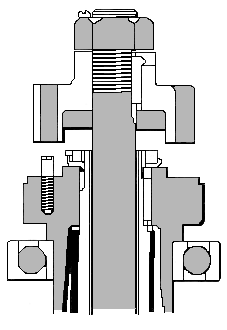 If the motor reverses due to phase reversal or some other fault condition and the line shaft pump joints start to unscrew, it will uncouple before the shaft completely unscrews. This is a safety feature to keep from damaging the pump and line shafting. In most cases, our customers call for 30% momentary upthrust and this means the coupling must be bolted to handle this condition. The coupling is no longer capable of self-release. If upthrust and non-reversing protection are both required, a non-reverse ratchet should be specified.
If the motor reverses due to phase reversal or some other fault condition and the line shaft pump joints start to unscrew, it will uncouple before the shaft completely unscrews. This is a safety feature to keep from damaging the pump and line shafting. In most cases, our customers call for 30% momentary upthrust and this means the coupling must be bolted to handle this condition. The coupling is no longer capable of self-release. If upthrust and non-reversing protection are both required, a non-reverse ratchet should be specified.
Steady Bushings
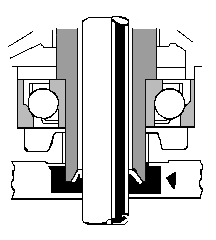 These are available for HOLLOSHAFT® designs to support the pump customer's head shaft at the lower end of the motor. This effectively supports the head shaft to prevent whip against the pump seal.
These are available for HOLLOSHAFT® designs to support the pump customer's head shaft at the lower end of the motor. This effectively supports the head shaft to prevent whip against the pump seal.
Vertical Motor Thrust Bearings
All Vertical motors are capable of axial thrust loads as specified on the price sheets. Special motors, such as Inline and Aerator bearings, will be covered with the motor due to specific application requirements.
1. Thrust loads on bearings is comprised of weights of rotor, pump shafting, impellers and the hydraulic load. Pump conditions that effect life beyond weight are hydraulic force, up or down, duration of hydraulic thrust, up or down, and magnitude at various conditions of load. It is important that pumps that operate at or near shut-off for long periods should be sized for with proper bearing system.
2. Bearing life. In determining and specifying bearing life, the customer should consider hours of operation, safety factor, application and efficiency. The many specifications tend to be conservative on specifying bearing life. They may force motor designers to furnish a bearing system that may not operate properly for the application or efficiently. Low thrust conditions with long bearing life may force the designer to spherical or plate bearing. Of course, these are more costly and lead to less efficient motors. The larger the thrust bearing the more heat that must be dissipated.
Another consideration when specifying long life is failure due to atmospheric conditions or contamination of bearing. It is not feasible to expect over fifteen years life unless application is mild and maintenance excellent.
The standard for U.S. MOTORS® brand products is one year minimum, five year average, as determined by AFBMA B-10 method. This means that at the end of one year of continuous operation, 90% of the bearings will be operating satisfactorily at rated load. Most applications do not require the motor to operate one year (8,700 hours) continuously.
At a given speed, the time required for fatigue failure of a bearing varies inversely with the third power of the imposed load. This means that if a bearing was loaded to only half of capacity, bearing life would increase eight times, or 40 years, average.
The following table may be used for discussing various loads and life:
| Load/Life | Avg. Life 8 hr./day |
Avg. Life 24 hr./day |
Min. Life 8 hr./day |
Min. Life 24 hr./day |
| 100% rated load 85% rated load 75% rated load |
15 yrs. 20 yrs. 38 yrs. |
5 yrs. 8 yrs. 12.5 yrs. |
3 yrs. 5 yrs. 7.5 yrs. |
1 yr. 1.6 yrs. 2.5 yrs. |
The thrust bearing on 320 frame open motors and 400 frame TEFC and larger is placed at the top of the motor for ease of inspection and replacement without complete disassembly of motor. Lower guide bearings have almost infinite life if operated with only momentary upthrust.
3. High thrust bearings.
Angular Contact Thrust Bearings
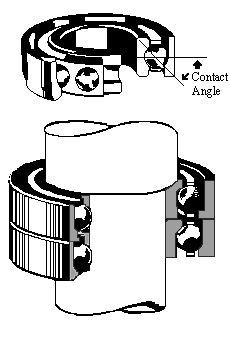
These bearings are standard on all ratings. The amount of thrust capacity for a given bearing is determined by the angle of contact. Types used for Turbine Pump motors usually have 35 to 400 angle. Another factor which can influence bearing life is construction of the retainer which guides the balls. Since thrust bearings maintain a continuous load on each ball, any variation in speed must be corrected by the retainer.
Angular contact bearings can be stacked for increased thrust capacity. The bearings must be accurately ground so they will share the load. Two bearings will give approximately 165% of the capacity of one bearing.
Another feature of angular contact bearings is that they seldom require water cooling.
Spherical Thrust Bearings
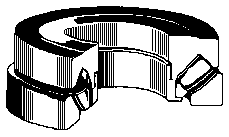 When longer life or higher thrust capacity cannot be provided by angular contact bearings, spherical thrust bearings are used. This bearing will take some radial load but only if thrust is applied at all times. Spring loading is employed to insure the bearing will not be damaged during starting and momentary upthrust conditions. These springs push up against the lower race so the lower race is kept in contact. Since the spring pressure may be several thousand pounds, a considerable load is imposed on the guide bearing during start-up. Care must be taken not to specify life factors that would cause bearing failures due to insufficient load during normal operation.
When longer life or higher thrust capacity cannot be provided by angular contact bearings, spherical thrust bearings are used. This bearing will take some radial load but only if thrust is applied at all times. Spring loading is employed to insure the bearing will not be damaged during starting and momentary upthrust conditions. These springs push up against the lower race so the lower race is kept in contact. Since the spring pressure may be several thousand pounds, a considerable load is imposed on the guide bearing during start-up. Care must be taken not to specify life factors that would cause bearing failures due to insufficient load during normal operation.
Plate Bearings
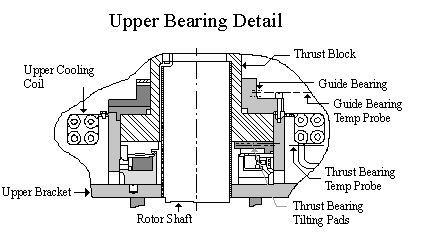
These have practically an unlimited life factor if the thrust capacity is properly selected, lubricated, cooled and not overloaded. Vibration, cavitation and heat can severely affect the life of a plate bearing. Construction of this bearing calls for a solid plate runner and segmental pivoted shoes with the runner riding on a film of oil between it and the bearing shoes.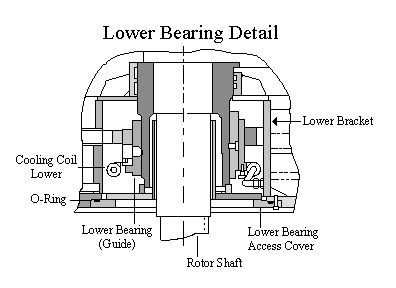
Operation at higher loads than designed for or higher temperatures may break down the film of oil and destroy the bearing.
The guide bearings are usually anti-friction type for the 6800 and 8000 frames and sleeve for the 9600 frame.
It is extremely important that all thrust conditions be given at time of inquiry. Of the three types of bearings used on high thrust machines, plate bearing efficiencies must be quoted with thrust losses. Plate bearing efficiencies are considerably lower than spherical bearing efficiencies and water cooling is always necessary.
Ball & Roller Bearing Losses
The efficiencies listed on typical datasheets are for vertical ball bearing motors with no bearing larger than standard and zero thrust load.
Motor efficiency will be less when:
- Extra high thrust motors are required.
- Motor is carrying any external thrust load.
Typical calculations for correcting motor efficiency to allow for ball type thrust bearings is:
Thrust Loss = Approximately .0075 HP per 100 RPM per 1000 lbs. of thrust.
Spherical roller bearings vary by size and should be referred to Engineering.
Bearing Protective Devices
Various types of monitoring devices are available for the upper bearing on WPI, 320 and larger and TEFC, 400 and larger frames. It is necessary for the customer specification and edit sheet to clearly define type of device to be supplied. Some monitors are designed for oil temperature and others for bearing temperature. Obviously, ambient operating temperature is important in determining the type required. Oil temperature devices would do little good when operating outside in frigid weather; resistance detectors on the bearing race would be required.
- Bearing thermometers are used on oil lubricated motors, normally operating in a controlled ambient. Oil temperature is indicated rather than bearing temperature.
- Thermistors (THERMA-SENTRY) can be used on grease or oil lubricated motors. A small sensing element is placed at or near the bearing to sense actual bearing temperature. If a THERMA-SENTRY is specified, a relay is provided to send an impulse to the customer's monitor. Any other type requires the customer to provide a relay or other control device to monitor the RTD's.
- Bearing thermocouples can be provided for oil or grease lubricated bearings. The elements are normally placed near the bearing to sense actual temperatures. Thermocouples generate a voltage to a monitoring device supplied by the customer. Edit sheets must specify the desired type of thermocouple to serve control.
- Bearing temperature relay is temperature sensitive. The sensor is a bulb and generally indicates oil temperature. Most are placed close to the bearing. Our standard device has a 5 amp rating and is of the Fenwal or Minco type.
- Resistance Temperature Detector (RTD)

